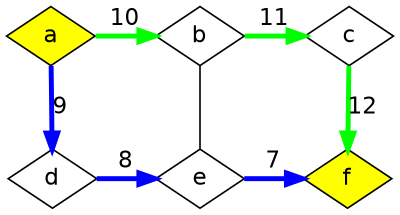-
Notifications
You must be signed in to change notification settings - Fork 2
Theory
Let's take a simple city with six nodes representing six intersections without lights and no turn restrictions. This means that at every interesection you may turn in any direction and won't spend any extra time. So only time spent on edges (road segments between intersections) will be taken into account.

Now you ride from a to f over b and c and need 10 + 11 + 12 = 33
seconds (green):

The next day you ride from a to f over d and e and need `9
- 8 + 7 = 24` seconds (blue):

The blue a→d→e→f would be currently the “optimal” route.
But on the third day you make a short round-trip a→b→e→d→a in
15 + 5 + 9 + 9 = 38 seconds (red).
This trip even does not reach f and on the first segment a→b it was slower
than the green one (because of more traffic).

Now we get three possible paths from a to f:
-
a→d→e→fis the blue one with 24 seconds -
a→b→c→fis a combination of green and red. Minimum is 33 seconds (10 + 11 + 12, maximum is 38 seconds (15 + 11 + 12) -
a→b→e→fwith a combination of green, red, and blue and 22 to 27 seconds
Which is the fastest route?
Depends. You can already forget about a→b→c→f, which is ALWAYS slower than
the other two. But what probability of success do you expect?
All edges have one value, except for a→b, which has two: 10 and 15. If
you're optimistic about your next trip and hope to repeat your best time, then
the path a→b→e→f will take 10 + 5 + 7 = 22, which is better than a→d→e→f
9 + 8 + 7 = 24.
If you want to “make sure” you arrive in time, expect you'll need 15 seconds
for a→b and therefore is a→d→e→f the better choice.